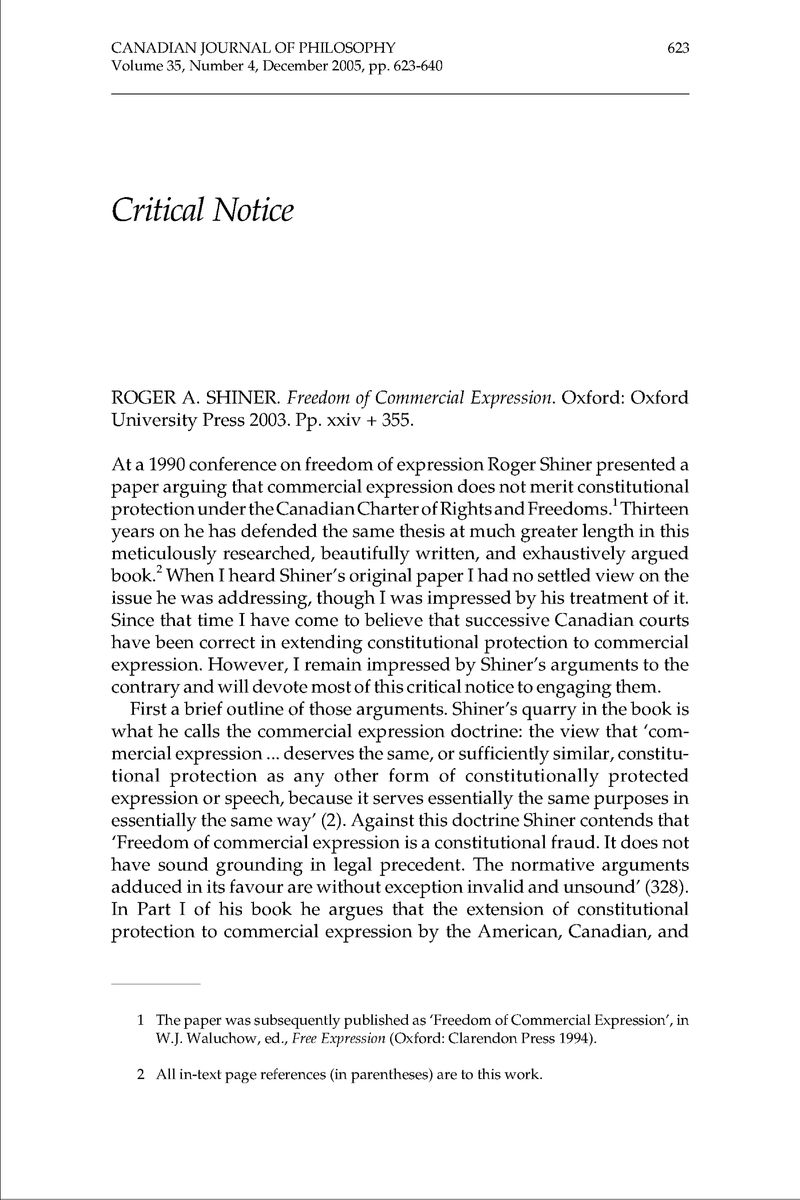Published online by Cambridge University Press: 01 January 2020

1 The paper was subsequently published as ‘Freedom of Commercial Expression', in Waluchow, W.J. ed., Free Expression (Oxford: Clarendon Press 1994)Google Scholar.
2 All in-text page references (in parentheses) are to this work.
3 R. v. Keegstra, (1990) 3 S.C.R. 697; R. v. Butler, (1992) 1 S.C.R. 452.
4 Irwin Toy Ltd. v. Quebec, (1989) 1 S.C.R. 927, at 969-70.
5 These implications have been noted in Kent|Greenawalt, Fighting Words: Individuals, Communities, and Liberties of Speech (Princeton: Princeton University Press date???), 20-1.
6 On the question of liberty, see R. v. Malmo-Levine, (2003) SCC 74, paras. 84-9. On the question of security, see Chaoulli v. Quebec (Attorney General), (2005) SCC 35, paras 204-7.
7 Keegstra,845
8 R. v. Oakes, (1986) 1 S.C.R. 103.
9 Keegstra, 787. Dickson also observed that hate propaganda ‘strays some distance from the spirit of s. 2(b)’ (766) and that it is ‘distant from the core of free expression values’ (787).
10 Keegstra, 766
11 Keegstra, 767
12 ‘To become transfixed with categorization schemes risks losing the advantage associated with this sensitive examination of free expression principles, and I would be loath to sanction such a result’ (Keegstra, 767).
13 Keegstra, 785,765 respectively
14 Butler, 509; cf. 500
15 Canadian Broadcasting Corporation v. New Brunswick (Attorney General), (1996) 3S.C.R. 480, at 512-13
16 Keegstra, 841
17 RJR-MacDonald Inc. v. Canada (Attorney General), (1995) 3 S.C.R. 199, at 347
18 R. v. Lucas, (1998) 1 S.C.R. 439, at 488
19 E.g., La Forest in RJR-MacDonald, 279
20 Irwin Toy, 976
21 Incidentally, Shiner sometimes seems to slide into associating commercial expression particularly with corporate advertising: ‘If freedom of expression is thought primarily to protect the normative position of those who express, or speak, then the typical expresser in the case of commercial expression is a corporation, and not a natural person’ (168). But this association neglects the fact that many advertisements are posted or circulated by natural rather than artificial persons, as well as the fact that many such persons have incorporated themselves for legal reasons but remain otherwise entirely natural. While most advertising, and especially the most visible forms of advertising, may be corporate in the stronger sense Shiner intends, not all of it is.
22 Mill, John Stuart On Liberty,’ in Robson, J.M. ed., Essays on Politics and Society (Toronto: University of Toronto Press 1977), 223Google Scholar
23 On Liberty,’ 225-6
24 Ibid.
25 On Liberty,’ 276
26 On Liberty,’ 292